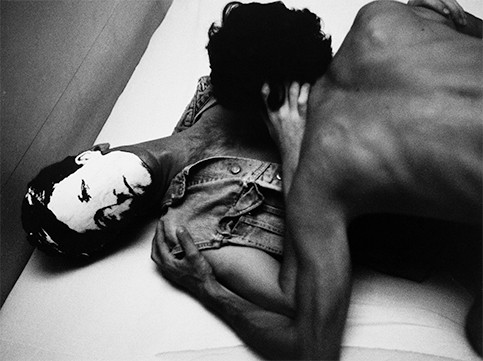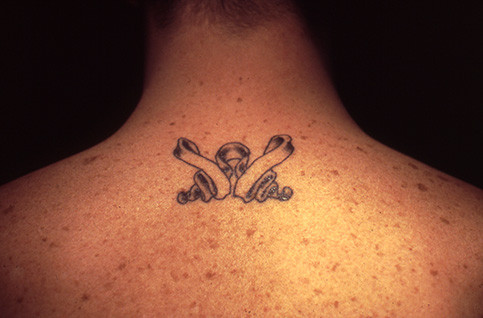David Wojnarowicz & Robert Blanchon
07 Mar - 23 May 2015

David Wojnarowicz
‘Arthur Rimbaud in New York’, 1978–79
From a series of twenty-four gelatin-silver prints
8 x 10 inches, each
Courtesy of the Estate of David Wojnarowicz and P.P.O.W Gallery, New York
‘Arthur Rimbaud in New York’, 1978–79
From a series of twenty-four gelatin-silver prints
8 x 10 inches, each
Courtesy of the Estate of David Wojnarowicz and P.P.O.W Gallery, New York

Robert Blanchon
‘Self-Portrait with Tattoo’, 1993
Cibachrome print, 28 x 35 cm
Courtesy The Estate of Robert Blanchon
‘Self-Portrait with Tattoo’, 1993
Cibachrome print, 28 x 35 cm
Courtesy The Estate of Robert Blanchon
DAVID WOJNAROWICZ & ROBERT BLANCHON
7 March – 23 May 2015
‘Feeling animalistic. Feeling Hyena.
Feeling Wolf. Feeling Dog. I am tongue and heart.’
(David Wojnarowicz)
The Grazer Kunstverein continues to question the concept of social abstraction by presenting work by two exceptional American artists who have both gained cult status in the United States. Each of their practices investigates and translates the personal and physical relationship towards their surroundings.
The works of David Wojnarowicz and Robert Blanchon reflect upon the United States in the 1980s and throughout the 90s, when gay and queer politics were severely suppressed and questioned during the rise of the HIV/AIDS virus. The poetic but often direct approach of these two AIDS activists represents a period that currently seems to gain more prominence due to the neo-liberal ideologies that are forced upon our perception of society.
David Wojnarowicz (1954–1992) was a painter, photographer, writer, filmmaker, performance artist, and activist who was prominent in the New York City art world of the 1980s. Many of Wojnarowicz’ works incorporate outsider experiences drawn from his personal history. By the late 1970s he had, in his own words, ‘started developing ideas of making and preserving an authentic version of history in the form of images/writings/objects that would contest state-supported forms of “history.”’
A member of the first wave of East Village artists, Wojnarowicz began showing his work during the early 1980s in such now-legendary spaces as Civilian Warfare, Club 57, Gracie Mansion, Fashion Moda, and the Limbo Lounge. He gained prominence through his inclusion in the 1985 Whitney Biennial, and was soon showing in numerous museum and gallery exhibitions throughout the United States, Europe, and Latin America. In the late 1980s, after he was diagnosed with AIDS, Wojnarowicz’ art took on a sharply political edge, and soon he was entangled in highly public debates about medical research and funding, morality and censorship in the arts, and the legal rights of artists.
Wojnarowicz’ urban experience in New York, from his childhood hustling in Times Square to his adult life wandering among the abandoned warehouses on the Hudson River piers, counters the notion of the urban as the be-all and end-all of queer community and style. According to American theoretician Kath Weston, the urban is constructed in opposition to the rural as a place of violence and threats for queer or gay subjects. As she states, ‘From the start, then, the gay imaginary is spatialized, just as the nation is territorialized. The result is a sexual geography in which the city represents a beacon of tolerance and gay community, the country a locus of persecution and gay absence.’
Robert Blanchon (1965–1999) was an American artist born in Foxboro, Massachusetts. His conceptual artworks often dealt with histories of American Conceptual Art, the politics of AIDS, and representations of queer sexuality. Blanchon attended the School of the Art Institute of Chicago from 1984 to 1989, earning both a BFA and a MFA. While in Chicago, Blanchon was an active participant in the non-profit art scene, curating exhibitions at N.A.M.E. gallery, contributing to Tony Tasset, et al.’s artist project Anonymous Museum, and designing a poster for the City of Chicago’s billboard campaign Art Against AIDS: On the Road.
From 1989 to 1994, Blanchon lived in New York City and worked in the communications department of the New Museum of Contemporary Art while producing his photographic, sculptural, performance, and video artworks. He had a studio on Canal Street where he completed many of his early photographic series, including the stains, tattoos, and greeting cards series. Also during this period, Blanchon created two of his best known and most exhibited artworks, ‘Untitled (self-portrait)’ (1991), a series of fourteen self-portraits commissioned by street artists, and ‘Protection’ (1992), a letter from the artist to his mother telling her he was HIV-positive, juxtaposed with her twelve-page response.
Blanchon had solo exhibitions in New York City at Artists Space in 1994 and at White Columns in 1995. In 1995, he moved to California to take a position as an artist-in-residence at the University of California, Irvine. While in California, he produced the video ‘let’s just kiss + say goodbye’ (1995), which was exhibited in national and international film festivals, and he had two solo shows, at the Los Angeles Center for Photographic Studies in 1996 and at Marc Foxx Gallery in the following year.
In the spring of 1998, Blanchon moved back to Chicago to become an artist-in-residence at the School of the Art Institute of Chicago, and in the fall of the same year, he took another artist-in-residence position at the University of North Carolina at Chapel Hill. By the end of the summer Blanchon was hospitalized due to complications related to AIDS, and on October 3, 1999, he died at the of age 33.
Developed in close collaboration with the NYU Fales Library, New York, this unique exhibition concentrates on the photography, videos, and films produced by the artists during their practice.
7 March – 23 May 2015
‘Feeling animalistic. Feeling Hyena.
Feeling Wolf. Feeling Dog. I am tongue and heart.’
(David Wojnarowicz)
The Grazer Kunstverein continues to question the concept of social abstraction by presenting work by two exceptional American artists who have both gained cult status in the United States. Each of their practices investigates and translates the personal and physical relationship towards their surroundings.
The works of David Wojnarowicz and Robert Blanchon reflect upon the United States in the 1980s and throughout the 90s, when gay and queer politics were severely suppressed and questioned during the rise of the HIV/AIDS virus. The poetic but often direct approach of these two AIDS activists represents a period that currently seems to gain more prominence due to the neo-liberal ideologies that are forced upon our perception of society.
David Wojnarowicz (1954–1992) was a painter, photographer, writer, filmmaker, performance artist, and activist who was prominent in the New York City art world of the 1980s. Many of Wojnarowicz’ works incorporate outsider experiences drawn from his personal history. By the late 1970s he had, in his own words, ‘started developing ideas of making and preserving an authentic version of history in the form of images/writings/objects that would contest state-supported forms of “history.”’
A member of the first wave of East Village artists, Wojnarowicz began showing his work during the early 1980s in such now-legendary spaces as Civilian Warfare, Club 57, Gracie Mansion, Fashion Moda, and the Limbo Lounge. He gained prominence through his inclusion in the 1985 Whitney Biennial, and was soon showing in numerous museum and gallery exhibitions throughout the United States, Europe, and Latin America. In the late 1980s, after he was diagnosed with AIDS, Wojnarowicz’ art took on a sharply political edge, and soon he was entangled in highly public debates about medical research and funding, morality and censorship in the arts, and the legal rights of artists.
Wojnarowicz’ urban experience in New York, from his childhood hustling in Times Square to his adult life wandering among the abandoned warehouses on the Hudson River piers, counters the notion of the urban as the be-all and end-all of queer community and style. According to American theoretician Kath Weston, the urban is constructed in opposition to the rural as a place of violence and threats for queer or gay subjects. As she states, ‘From the start, then, the gay imaginary is spatialized, just as the nation is territorialized. The result is a sexual geography in which the city represents a beacon of tolerance and gay community, the country a locus of persecution and gay absence.’
Robert Blanchon (1965–1999) was an American artist born in Foxboro, Massachusetts. His conceptual artworks often dealt with histories of American Conceptual Art, the politics of AIDS, and representations of queer sexuality. Blanchon attended the School of the Art Institute of Chicago from 1984 to 1989, earning both a BFA and a MFA. While in Chicago, Blanchon was an active participant in the non-profit art scene, curating exhibitions at N.A.M.E. gallery, contributing to Tony Tasset, et al.’s artist project Anonymous Museum, and designing a poster for the City of Chicago’s billboard campaign Art Against AIDS: On the Road.
From 1989 to 1994, Blanchon lived in New York City and worked in the communications department of the New Museum of Contemporary Art while producing his photographic, sculptural, performance, and video artworks. He had a studio on Canal Street where he completed many of his early photographic series, including the stains, tattoos, and greeting cards series. Also during this period, Blanchon created two of his best known and most exhibited artworks, ‘Untitled (self-portrait)’ (1991), a series of fourteen self-portraits commissioned by street artists, and ‘Protection’ (1992), a letter from the artist to his mother telling her he was HIV-positive, juxtaposed with her twelve-page response.
Blanchon had solo exhibitions in New York City at Artists Space in 1994 and at White Columns in 1995. In 1995, he moved to California to take a position as an artist-in-residence at the University of California, Irvine. While in California, he produced the video ‘let’s just kiss + say goodbye’ (1995), which was exhibited in national and international film festivals, and he had two solo shows, at the Los Angeles Center for Photographic Studies in 1996 and at Marc Foxx Gallery in the following year.
In the spring of 1998, Blanchon moved back to Chicago to become an artist-in-residence at the School of the Art Institute of Chicago, and in the fall of the same year, he took another artist-in-residence position at the University of North Carolina at Chapel Hill. By the end of the summer Blanchon was hospitalized due to complications related to AIDS, and on October 3, 1999, he died at the of age 33.
Developed in close collaboration with the NYU Fales Library, New York, this unique exhibition concentrates on the photography, videos, and films produced by the artists during their practice.
